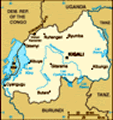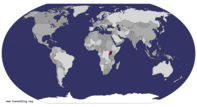Advertisement
On Monday, Jacintha's last full day in Rwanda, she and I went to see the Kigali Memorial Centre, which chronicles the genocide here in 1994, as well as several others that have happened in the last century.
The Centre itself is a small, nondescript white building on the side of one of the hills in Kigali. It looks like a house from a distance, but it is so, so much more, inside and out.
When we arrived at the Centre a guard at the gate searched us, the full bag-digging, pocket-emptying, pat-down type search. It was the first time this has ever happened to me here, even though I have gone into many government buildings, met two Cabinet Ministers, a 3-Star General of the Army and gone into the Canadian Embassy. This indicated to me how important this building is to the Rwandan people and government, and how seriously they take it's security. My pocket knife was taken by the guard, and returned to me once I left. I am not entirely sure the reason why they took the knife, whether it was for symbolic reasons (they don't want any weapons in a building commemorating a war/genocide) or for more

 Inside the Memorial
Inside the Memorial
I wasn't supposed to take pictures, but no one told me that until AFTER I'd taken at least 20.practical reasons, like they don't want the possibility of someone getting hurt if tempers erupt due to the sensitive nature of the material inside the Centre. I feel that whatever the reason, it is a good one, and I willingly handed over my knife, though there was a possibility that I would never see it again (the guard put it down on a table beside the gate where anyone could take it if he wasn't watching).
The Centre is surrounded by gardens on the sides, has a small parking lot on its up-hill side, and has mass-graves of 25,000 people on its down-hill side, the side that faces the city. The 25,000 people were interred at the Centre in coffins, after being exhumed from holes and ditches and wells around the city, on the 4th of April, 2004, the ten year anniversary of the start of the genocide. Yesterday, July 4th, is the anniversary of the end of the war (the genocide ended more than two weeks before the war ended, once the Interahamwe realized that the RPF would win and started running to escape the country).
Inside the Centre it is dark and quite, and people can look at
the various exhibits alone or as a group. Jacintha and I decided to go alone, as it would allow us to go at our own pace. There are six different exhibits on the main floor; Before the Genocide, Genocide, Aftermath, a room with pictures of victims donated by their surviving family, a room with the belongings (mostly clothing and identity cards) of victims, and a room with the mortal remains of victims (mostly skulls and leg and rib bones). The three main exhibits (Before, During and After) are in hallways that circle the walls of the lower levels, with a large open area in the middle with sculptures and art, as well as couches for sitting on. From the open area in the middle you can access the three separate rooms that house the other three exhibits.
Upstairs there are 7 rooms, 5 are one large exhibit titled "Wasted Lives" telling of other genocides (the Namibian Hereros 1904, Armenians in the Ottoman Empire in WWI, the Jews in WWII, Cambodia under Pol Pot and the Balkans in the 1990's), one large room dedicated to the stories of children, titled "Lost Future", and one room in which you can watch a
video of the ceremony held at the Centre on April 4th, 2004, commemorating one decade since the start of the genocide and the re-internment of the 25,000, mostly unknown people.
It was the stories of the children that really touched me. The room is set up so that every window (and there are many) has the picture of a child covering it (so the pictures are naturally lit from outside and it gives the room a pale glow), and in front of each picture is a plaque that tells the childs name, age, favorite food/drink/dessert, best friend, favorite movie/book/song, sometimes their last words, and how they died, all written in Kinyarwanda, French and English. All of the stories are sad and I wept a bit, but some stuck with me more than others.
One child named David (6 years old) said to his mother, "don't worry, UNAMIR will save us", moments before being caught by the genocidaires and being tortured to death.
One baby (whose name I wrote down, but I forgot to bring the paper with me) was shot in the head while his mother was running from the Interahamwe with him on her back. The bullet would have
other wise hit his mother between her shoulders, killing her. She survived the genocide.
Another baby had her head smashed against a wall (being swung by her feet), a method of killing usually used on cats.
One young boy was caught by the Interahamwe, having fallen while running away with his father and brother, and refused to tell his captors where his family was going. He was shot in the head, but his father and brother escaped and managed to hide, and both survived the genocide.
After going through all of the exhibits, which include descriptions of events in Kinyarwanda, French and English, pictures, videos and many artifacts (like a chain that held two friends together when they were buried alive, machetes that haven't been cleaned since they were last used, and identity cards distinctly labelled with "Hutu" or "Tutsi" which remind me of the identity cards from Nazi Germany that are stamped with large red "J"s to make finding Jews easy), Jacintha and I walked through the gardens and looked at the mass graves. In the picture of the graves in which you can see some coffins you will notice that they have a vibrant purple cloth on them.
This is the color that is used to commemorate/remember/mourn the victims of the genocide, and many people I saw in the Centre had bandannas of the same color tied around their necks.
The Center moved me more than I can describe. I have "studied" Rwanda for many years now, reading books and histories and anything else that I could think of, but it wasn't until I came to this Center that I really got a feel for the horror of what happened in the summer of 1994. The story is told from the perspective of the country and its people and the stories of the survivors told in the videos are horrific. Having seen evidence of the monster that a human can become, and seen it from closer than anyone would ever want to see, and yet not very closely at all, I feel that it is the responsibility of every person on the planet, every human who cares for another human, every organization and government and religion and group and small town book club, to do their utmost to ensure that this sort of thing never happens again. After every genocide that has occurred in the past century the

 Not Alone
Not Alone
Coffins in a mass grave behind the center.survivors have promised "never again". But "never again" has become "again and again" because not enough is being done to stop these things from happening. People and governments have yet to learn that sometimes other people matter more than you do, that you have to make sacrifices that may harm your nation or your people in order to save humanity as a whole.
At the beginning of the Rwandan genocide Gen. Dallaire told the U.N. that if he had 500 troops, he could stop the genocide. Instead his number of troops was steadily reduced as countries pulled out of the UNAMIR mission, fearing that their soldiers might be killed, feeling that what was happening was none of their business. These nations did, however, send troops to evacuate their nationals from Rwanda, and the troops were more than the 500 Gen. Dallaire asked for. And one asks oneself, "what if...?". What if those troops had been sent to evacuate the nationals, and then stayed to help UNAMIR? What if Dallaire had been given more troops and a stronger mandate at the beginning of the mission? What if....?
What if the Rwandan genocide is the turning point? What if after this one the world learns to help each other and use more decisive action to stop potential genocides? Judging by the current situation in Sudan, as well as the unrest and instability in the Middle East, Isreal and Iraq being at the forefront of media attention, I would say that Rwanda was and is not the turning point, but it certainly shook the world and has brought more attention to the issue. The Kigali Memorial Center was built and is run for this purpose, to inform people, bring more attention to the issue and educate people on how genocides occur, and hopefully help find out how they can be stopped. There is a Documentation Centre beside the Memorial Centre, where information is gathered and kept for two purposes: First, so that the genocide can be studied in great detail in hopes of finding patterns that can help identify and stop a potential genocide, and secondly to ensure that no one ever tries to deny that the genocide ever happened, as in the case of the "Holocaust Deniers".
I will never forget what I saw and felt in the Centre. It will stay with me forever as a reminder of what can happen when hate and greed overpower a people, when they turn on their friends, neighbors and even their own families, and cease to be humans, even for an instant.
For more on the Centre, visit www.kigalimemorialcentre.org
For more on the Genocide, visit en.wikipedia.org/wiki/Rwandan_Genocide
Also, there are many many books about the genocide, such as
Shake Hands With the Devil and
We Wish to Inform You That Tomorrow We Will Be Killed With Our Families: Stories From Rwanda .
Advertisement
Tot: 0.118s; Tpl: 0.015s; cc: 9; qc: 55; dbt: 0.0584s; 1; m:domysql w:travelblog (10.17.0.13); sld: 1;
; mem: 1.2mb











GoGo
non-member comment
Genocide
Kevin, this is your best blog yet. I don't know how you can capture and retain so much detail in one visit and describe it in one writing afterwards. I really do get a great insight into the Rwanda Holocaust. You would, among other things, make a great judge. You look at and listen to everything. You don't rush to judgement, excpt for crocodiles, and you are very disinterested as an observer. I really enjoy reading your blogs. I am now forwarding them to Philip Baker who has Diplomatic status and is on his way to being a big wheel in Africa. Be sure to save all your blog material. You have something that should be published. Keep up your plain old Calgary style. of writing. Don't get into literary flourishes, though. I am so impressed by you and what you have done and are doing. God bless.